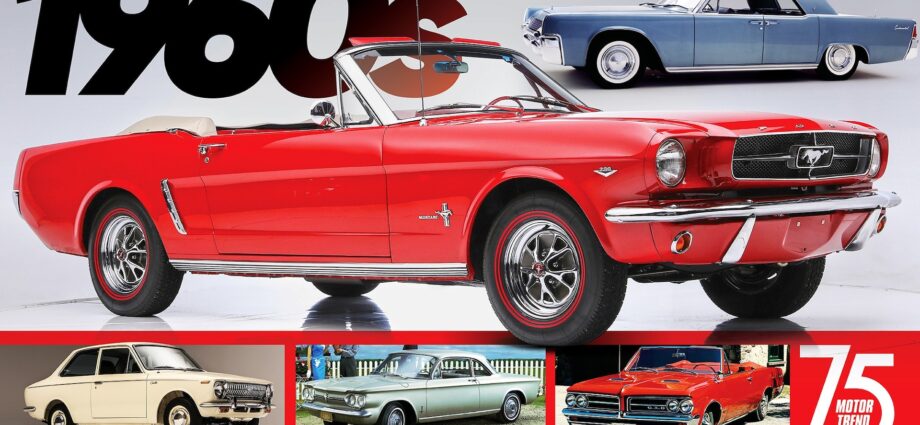As part of MotorTrend’s 75th anniversary, we look back at some of history’s most significant cars. A complete list would fill a book, so for each decade we select five notable vehicles that helped shape automotive history.
Introduction to the 1960s
The 1960s was a turbulent decade, with baby boomers hitting young adulthood and attitudes about everything, including music and sex, undergoing radical change. Society was whipsawed by Kennedy’s assassination, the Vietnam war, the Civil Rights movement, and a Cold War that brought us to the brink of nuclear doom—yet the decade ended with the achievement of Kennedy’s lofty goal to put humans on the moon. The car world, too, underwent seismic changes. While Detroit stayed fat on the youth-fueled muscle car craze, it slowly began to acknowledge the looming threat from foreign automakers. Indeed, the Big Four American automakers realized young buyers would turn their backs on domestic products just as quickly as they turned on Sinatra and segregation.
1960 Chevrolet Corvair
Domestic cars had seen few engineering breakthroughs since the end of WWII, but the Corvair showed how Detroit could innovate when properly motivated, in this case by the success of the Volkswagen Beetle. The Corvair broke free from Detroit engineering tradition with monocoque construction instead of body-on-frame, plus a four-wheel independent suspension and a rear-mounted, air-cooled engine with an optional turbocharger. Equally radical was what it didn’t have: no chrome grille and no tail fins. So revolutionary was the Corvair that MotorTrend named it our Car of the Year for 1960. Of course, Ralph Nader’s Unsafe at Any Speed delt irreparable damage to the Corvair’s legacy. Even though a 1972 government report found the Corvair’s stability comparable to contemporary compact cars, the Nader/Corvair affair brought a new emphasis on safety to both Detroit and Washington. With imports starting to peel sales away from Detroit’s Big Four, the Corvair gave car buyers a good reason to buy American—for a while, anyway.
1961 Lincoln Continental
From tragedy sprouts triumph: After the financial disaster of the 1958–60 Lincoln, the division left the 1950s in the past and created the luxury car of the future. The 1961 Lincoln Continental abandoned chrome and tail fins for a smooth, futuristic design that instantly rendered arch rival Cadillac as yesterday’s news. Based on a unibody platform shared with the Ford Thunderbird, the new Connie trimmed the typical plethora of body styles to just two, a four-door sedan and a four-door convertible, both employing rear-hinged “suicide” doors. Lincoln stood behind its emphasis on quality with an industry-first two-year, 24,000-mile bumper-to-bumper warranty. Although Lincolns had been presidential limos since the FDR administration, the association of the Connie with the nation’s youthful new president was a coup—until a fateful November day in Dallas linked them inextricably. The Continental somehow rose above this tragedy, casting a mold for luxury sedans that endured for decades.
1964 Pontiac GTO
The GTO, like the 1960s, was all about cultural revolution. Pontiac chief John DeLorean, considered a borderline subversive by GMs’ blue-suited management, exploited a loophole in corporate displacement limits and stuffed a 389-cubic-inch (6.4-liter) V-8 into the compact Tempest. The result was the GTO, a muscle car accessible by—and desirable to—the growing youth market. Pontiac anticipated 5,000 sales; it sold more than 32,000. The restyled ’65 GTO helped nab the 1965 MotorTrend Car of the Year award for the entire Pontiac division, while the all-new 400ci (6.6L) 1968 GTO took the award for itself. With smart updates like the low-cost 1969 GTO Judge (named for a comedy sketch on Rowan and Martin’s Laugh-In) and a 455ci (7.5L) V-8 for 1970, the GTO bestrode the muscle car genre like a colossus, right up until the oil crisis and emissions regulations brought the horsepower craze to an end.
1965 Ford Mustang
The Ford Mustang is one of the industry’s greatest successes. Lee Iacocca’s brainchild was designed to be stylish, sporty, and affordable by using chassis and drivetrain components from the Falcon and Fairlane to keep costs down. Ford hoped to sell 100,000 in the first year. Instead, it sold 22,000 on the first day and hit 100,000 sales in less than five months. Designed to be optioned as anything from an economy runabout to a personal luxury coupe to a fire-breathing V-8 track star, the Mustang’s cultural significance extended deep into pop culture with starring roles in car-themed films like Bullitt and Gone In 60 Seconds. Its success caught the industry off guard, and other automakers rushed to field competitors, known in deference to the Mustang as pony cars. Its rivals are mostly gone, but the Mustang remains in production, and 60 years later it is still pursuing its original mission goals.
1969 Toyota Corolla
The Corolla first came stateside in 1968 as a ’69 model, two years after its Japanese debut and at a time when Americans still regarded Japanese cars as cheap, tinny, underpowered curiosities. But there was something different about the Corolla, something beyond its expected frugality and unexpected build quality: It had genuine appeal. By the mid-1970s, the Toyota Corolla had become the world’s bestselling car. By the mid-1980s it had forced American automakers to rethink their approach to economy and quality. By the late 1990s it had surpassed the Ford Model T and Volkswagen Beetle to become the bestselling nameplate in history. There have been sporty Corollas and boring Corollas and even Corollas badged as Chevrolet Novas, but the basic formula never changed: Corollas are still sensible, economical, and reliable. Toyota has sold more than 50 million Corollas globally, with the total ticking higher every day.
MotorTrend thanks Matt Anderson, automotive historian and curator of transportation at The Henry Ford Musem of American Innovation, for his assistance with our Most Significant Cars of the Decades series.

